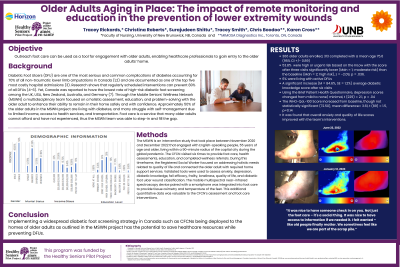Clinical Research
(CR-055) Healthy Seniors Aging in Place - The impact of remote wound monitoring and education in the Prevention of lower extremity wounds for seniors
Friday, April 28, 2023
7:15 PM - 8:30 PM East Coast USA Time

Tracey Smith, RN; Surajudeen Shittu, B.Pharm, PhD; Christina Hawkins-Roberts, RN; Chris Boodoo, MSc; Karen Cross, MD, PhD, FRCSC
Introduction: Seniors living below the poverty line and/or in rural communities often experience limited mobility and lack access to appropriate healthcare. A mobile person-centered footcare program was deployed as a tool for engagement to support safe aging-in-place and improve access to healthcare via remote monitoring. We describe findings on incorporating a mobile multispectral imaging system* to aid the footcare nurses with assessment of lower extremity wounds.
Methods: This intervention study enrolled seniors aged 55 years and older living in rural communities surrounding a mid-size city in New Brunswick, during the COVID-19 Pandemic. A Registered Nurse (RN) and Social Worker assessed seniors and followed them monthly over a 6-month period. The footcare component included an assessment using the mobile multispectral imaging system* to measure tissue oximetry, temperature, and risk assessment, and the InLow Diabetic Foot Risk screen, Diabetes Knowledge questionnaire and a physical assessment. With the senior’s permission, RNs provided education on diabetes, appropriate footwear, and active range of motion, and referred individuals at risk for lower extremity or wound complications to specialized healthcare services, including wound and vascular clinics.
Results: Of the 344 participants included in the analysis, 53.8% were high or urgent risk. 6% of these had active lower extremity wounds, some of which were long standing ( >2yrs). Use of the MIMOSA was important in making treatment decisions by the RNs. The RN delivered interventions and education were critical to improved feet and mobility as well as knowledge of diabetes. Using the Wilcoxon signed-rank test, participants’ average Inlow’s risk level after 3 visits were significantly lower (Mdn = 1; moderate risk category) than their risk level at baseline (Mdn = 2; high risk category), z = -2.09, p = .036. Participants’ knowledge of diabetes also improved (M = 85%, SE = 1.2%) significantly from baseline (M = 81%, SE = 1.3%), t(84) = -3.6, p < .001.
Discussion: Many wounds we encountered resulted from long standing improper footwear. The outreach footcare program focused on prevention using technology to support treatment, education, mobility, and health in seniors at risk for lower extremity wounds. Seniors voiced positive outcomes from interventions provided.
Methods: This intervention study enrolled seniors aged 55 years and older living in rural communities surrounding a mid-size city in New Brunswick, during the COVID-19 Pandemic. A Registered Nurse (RN) and Social Worker assessed seniors and followed them monthly over a 6-month period. The footcare component included an assessment using the mobile multispectral imaging system* to measure tissue oximetry, temperature, and risk assessment, and the InLow Diabetic Foot Risk screen, Diabetes Knowledge questionnaire and a physical assessment. With the senior’s permission, RNs provided education on diabetes, appropriate footwear, and active range of motion, and referred individuals at risk for lower extremity or wound complications to specialized healthcare services, including wound and vascular clinics.
Results: Of the 344 participants included in the analysis, 53.8% were high or urgent risk. 6% of these had active lower extremity wounds, some of which were long standing ( >2yrs). Use of the MIMOSA was important in making treatment decisions by the RNs. The RN delivered interventions and education were critical to improved feet and mobility as well as knowledge of diabetes. Using the Wilcoxon signed-rank test, participants’ average Inlow’s risk level after 3 visits were significantly lower (Mdn = 1; moderate risk category) than their risk level at baseline (Mdn = 2; high risk category), z = -2.09, p = .036. Participants’ knowledge of diabetes also improved (M = 85%, SE = 1.2%) significantly from baseline (M = 81%, SE = 1.3%), t(84) = -3.6, p < .001.
Discussion: Many wounds we encountered resulted from long standing improper footwear. The outreach footcare program focused on prevention using technology to support treatment, education, mobility, and health in seniors at risk for lower extremity wounds. Seniors voiced positive outcomes from interventions provided.

.png)

